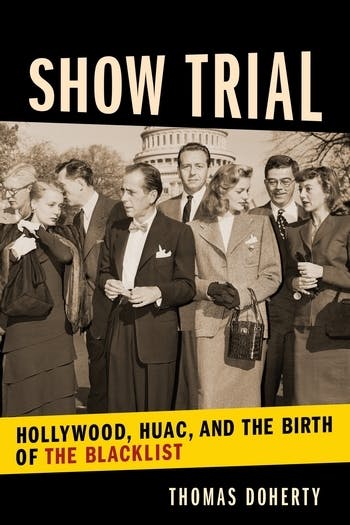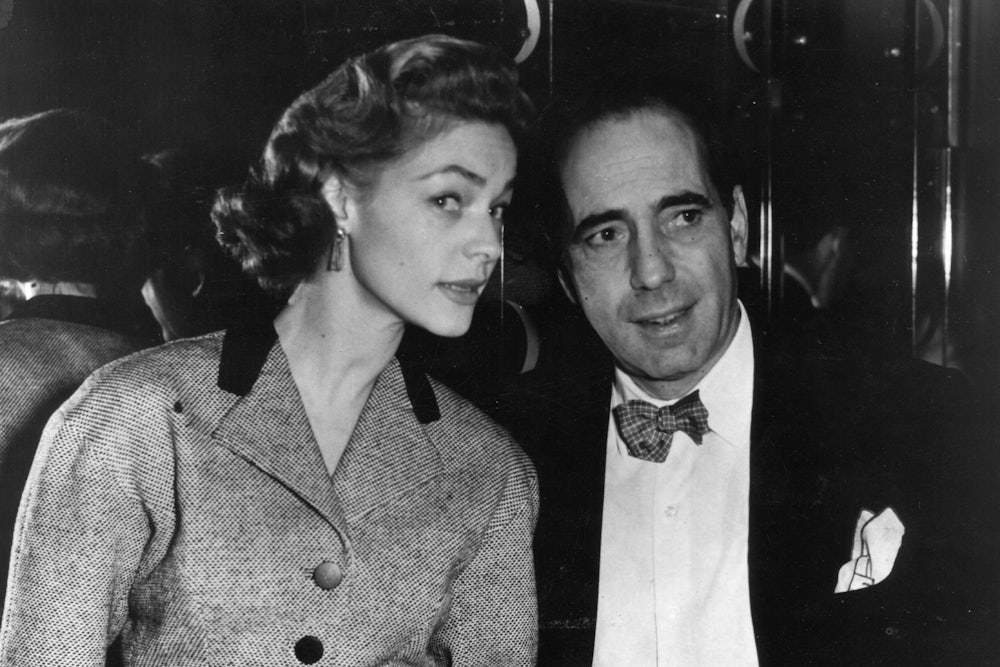“Are you now or have you ever been a member of the Communist Party?” Members of the House Committee on Un-American Activities raised this question with unrelenting zeal in a series of hearings over nine blustery and widely publicized days in October 1947. Spotlights flooded the hall and there was a row of cameramen perched at one side of the room, prompting an unnamed reporter from one of the movie industry trade papers to pronounce the atmosphere “worse than a Hollywood premiere.” Ten “unfriendly” witnesses, who refused to cooperate and skirted the issue of party membership—the Hollywood Ten, as they came to be known—were convicted of contempt and forced to serve jail time.

The basic plotlines of this story, the naming of names and the attendant recriminations, are by now well known. They’ve been recounted repeatedly in partisan memoirs and competing historical accounts. But just as the movies that were made during the war would be interpreted differently soon after it, so too the positions of many of the players involved in the HUAC proceedings changed over time, complicating the dominant narrative of good versus evil and challenging our assumptions about the period. Each player made by turns virtuous and dubious decisions, but what’s perhaps more interesting than the choices themselves is the climate in which they were made and the period-specific rhetoric employed to express them.
Film scholar Thomas Doherty opens his deeply absorbing, expertly researched, and thoroughly entertaining Show Trial: Hollywood, HUAC, and the Birth of the Blacklist by observing how, on the wings of these famous and infamous hearings, the Cold War came to Hollywood. Writer Lillian Hellman branded the whole affair “a honky tonk show.” The nattily dressed Committee chairman, New Jersey Republican J. Parnell Thomas, called the October hearings “the best show the committee has yet had.” And a clear-eyed editor from The Hollywood Reporter asked “how easier can the personnel of that committee get their names in print than by an attempted shakedown of motion pictures and their personalities?”
Before getting to the actual hearings, Doherty, whose previous books include a superb study of Hollywood’s fractious relationship with Nazi Germany and a probing account of censorship czar Joseph Breen, takes the reader on an illuminating tour of the Hollywood Left and their antagonists during the 1930s. After Hitler’s rise to power in January 1933, a segment of the picture business, particularly well represented among members of the Popular Front and those “faithful to the party line,” formed the Hollywood Anti-Nazi League. On January 30, 1938, to commemorate the fifth anniversary of Hitler’s takeover, the illustrious group—whose members included A-list actors John Garfield, Karen Morley, Edward G. Robinson, and Gayle Sondergaard—assembled a massive anti-Nazi rally in Los Angeles at the Shrine Auditorium. “I was in on the birth of Hollywood League Against Nazism when it started with seven members in 1936,” writer Dorothy Parker told a crowd of thousands. “Now, the Hollywood Anti-Nazi League has more than 5,000 members. That must prove that it is a real necessity.” (Less than a decade later, in light of the HUAC hearings, Parker would ruefully quip, “Fascism isn’t coming—it’s here!”)
Even at the time, this anti-fascist stance wasn’t enough to shield the activists from government investigation—not least because of a rather strident current of isolationism in the United States aimed at avoiding “foreign entanglements,” including with Nazi Germany. By June of 1938, Texan congressman Martin Dies had assembled a “Special Committee to Investigate Un-American Activities and Propaganda in the United States” in the U.S. Congress. Like its successor committee, reconstituted nearly a decade later, its chief target was Communists. “Almost everybody in Hollywood except Mickey Mouse and Snow White has been signed up by the Communists at one time or another,” declared one of the early testimonials delivered to the Dies Committee.
Initially, the main fear was directed at fifth columnists, who were thought to be taking root in Hollywood. But plenty of it was also driven by a toxic blend of nativism and anti-Semitism. With increasing frequency, Communists were spoken of, and indeed attacked, in the same breath as Jews. The vocal isolationist faction in Congress, and elsewhere, suspected that Jewish moguls in Hollywood were beating the drums of war, that they had a special personal stake in defeating Hitler, and, worse still, that “ethno-religious solidarity outweighed their patriotic duty to America.” Among those called to testify in September 1941 was Harry Warner, president of Warner Bros., whose 1939 film Confessions of a Nazi Spy had ushered in a wave of anti-Nazi pictures made in Hollywood. “In truth,” he told the senators with considerable pride, “the only sin of which Warner Bros. is guilty is that of accurately recording on the screen the world as it is or has been.”
Just a few weeks later, after the bombing of Pearl Harbor and the declaration of war, the isolationist faction in Congress had the wind taken out of its sails. Now that the Office of War Information mandated that all motion pictures should on some level support the Allied war effort, several of the major studios suddenly had no qualms about making movies that tipped their hat to our Soviet allies. Among the well-known examples discussed by Doherty are The North Star (1943), made at RKO from an original screenplay by Lilian Hellman, and Mission to Moscow (1943), a Warner Bros. film crafted by Casablanca co-writer Howard Koch. None other than J. Edgar Hoover would lambaste the latter picture during the HUAC proceedings as “a prostitution of historical facts.” Both movies cast their Russian subjects—members of the partisan resistance in the first instance and Stalin himself in the second—in a sympathetic light, but this did not strike moviegoers or critics at the time as inflammatory, propagandistic, or even impolitic.
In the early years of the Cold War, the public mood sharply changed. What is perhaps most striking in Doherty’s instructive account is the Red Scare vitriol that emanated from observers, commentators, and the general public. On a radio show called America’s Town Meeting of the Air, broadcast in early September 1947 from Los Angeles’ Philharmonic Auditorium, Ginger Rogers’s mother Lela fulminated against the perceived “Communist threat [that] is everywhere,” insisting that the Screen Writers Guild is “loaded with Communists.” Likewise, influential Hollywood columnist Hedda Hopper, who purportedly had 35 million readers at her peak, fanned the flames of anti-Communism. “Things I’d like to see,” she wrote in the run-up to the hearings, “all our fellow travelers, who have such a passion for Russia, on a boat headin’ in that direction.” Hopper later published a letter from an anonymous housewife, who alleged that she kept a large sheet of butcher paper on a kitchen wall, and with a red crayon would write the names she learned from the HUAC hearings; before going to see a movie, she would then check the names of the writer and director to make sure the picture “had a clean bill of health.”
These sentiments didn’t go unchallenged. Directors William Wyler, John Huston, and Billy Wilder, together with writer Philip Dunne and an all-star cast of actors—Gene Kelly, Rita Hayworth, Ava Gardner, Humphry Bogart and Lauren Bacall, among others—forged what they called the Committee for the First Amendment, voicing their fierce opposition to the HUAC hearings. They gathered to discuss their ideas at Chasen’s restaurant and, on occasion, in the offices of agent Sam Jaffe, who represented Bogie and others. Many of the same actors recorded a pair of 30-minute radio shows titled Hollywood Fights Back! Gracing the book’s cover is a photo of Bogart and Bacall, with Paul Henreid between them—Henreid staring into the camera and looking every bit as much the great leader of an underground movement as he did as Victor Laszlo in Casablanca half a decade earlier.
Despite their firm convictions, and their deep-seated opposition to HUAC, quite a few of the actors were loath to be branded Communist sympathizers. When greeted by a group of fans in St. Louis, on the way to Washington, Bogart claimed, “I wouldn’t know a Communist if I saw one.” Yet, after his highly publicized appearance on Capitol Hill, with a picture of him landing on the front page of the Daily Worker, the official publication of the Communist Party USA, he felt the need to renounce Communism publicly (“I detest Communism just as any other decent American does,” he told the press, with Bacall at his side) and published an article in Photoplay magazine titled “I’m No Communist.”
While the blacklist completely stunted, if not undid, the careers of the Hollywood Ten, driving quite a few into exile and others to work behind a front, the friendly witnesses managed to profit in tangible ways from the hearings. Doherty notes such cases of political opportunism and career advancement as actor Robert Montgomery, whose post as chief media advisor to President Eisenhower came in part from the political and media savvy he demonstrated for HUAC, and Ronald Reagan, who parlayed his telegenic skills and anti-Communist testimony (“I abhor the Communist philosophy but more than that I detest their tactics,” he happily told HUAC, though he notably refrained from naming names) into two terms as governor of California and, a decade later, two more as president.
“From a hard-nosed business perspective,” observes Doherty, with sober detachment, “the blacklist was a splendid success.” Through their carefully choreographed efforts to expunge the studios of any and all known Communists and fellow travelers, the Hollywood moguls were able to convince Washington and the movie-going public that they were at core true patriots. Loyal Americans, like the housewife who wrote to Hedda Hopper, could go to the movies with a clear conscience. To jeopardize the ample box-office profits on which they relied was, for most studio producers, and for a sizeable number of writers, directors and actors, not an option.
In the final chapters of Show Trial, Dougherty recounts, with great skill and the same even-handedness applied throughout the book, the untimely death of John Garfield in May 1952, at age 39, and the crowd of 10,000 loyal fans that filled the streets outside Riverside Memorial Chapel. Garfield had been pursued at different points by dogged HUAC officials and by tabloid reporter Victor Riesel, who was threatening to publish an exposé of the actor and his alleged ties to a vast Communist conspiracy in Hollywood. On May 21, he was found dead in the Gramercy Park apartment of his lover, actress Iris Whitney. Although Garfield, like Bogart before him, had been willing to put on a contrite public face, preparing a piece for Look magazine titled “I Was a Sucker for a Left Hook,” he surely suffered during this time. His dear friend actor Clifford Odets, who delivered the eulogy, attributed his heart attack unequivocally to “the witch hunters searching his closets.”
A more forgiving Dalton Trumbo asserted, in a speech he delivered at the Writers Guild in 1970, “it will do no good to search for villains or heroes or saints or devils because there were none; there were only victims.” (This was an especially startling shift for Trumbo, who had previously excoriated HUAC as “the beginning of an American concentration camp.”) By contrast, in a letter to Albert Maltz, written a few years later, Ring Lardner Jr. saw no ambiguity in the matter: “The choice we faced was between being ‘heroes’ and being complete shits.” The truth is of course more complicated than that, and Doherty’s refreshing approach adds quite a few new shades of gray to a story that has all too often been told in black-and-white.
